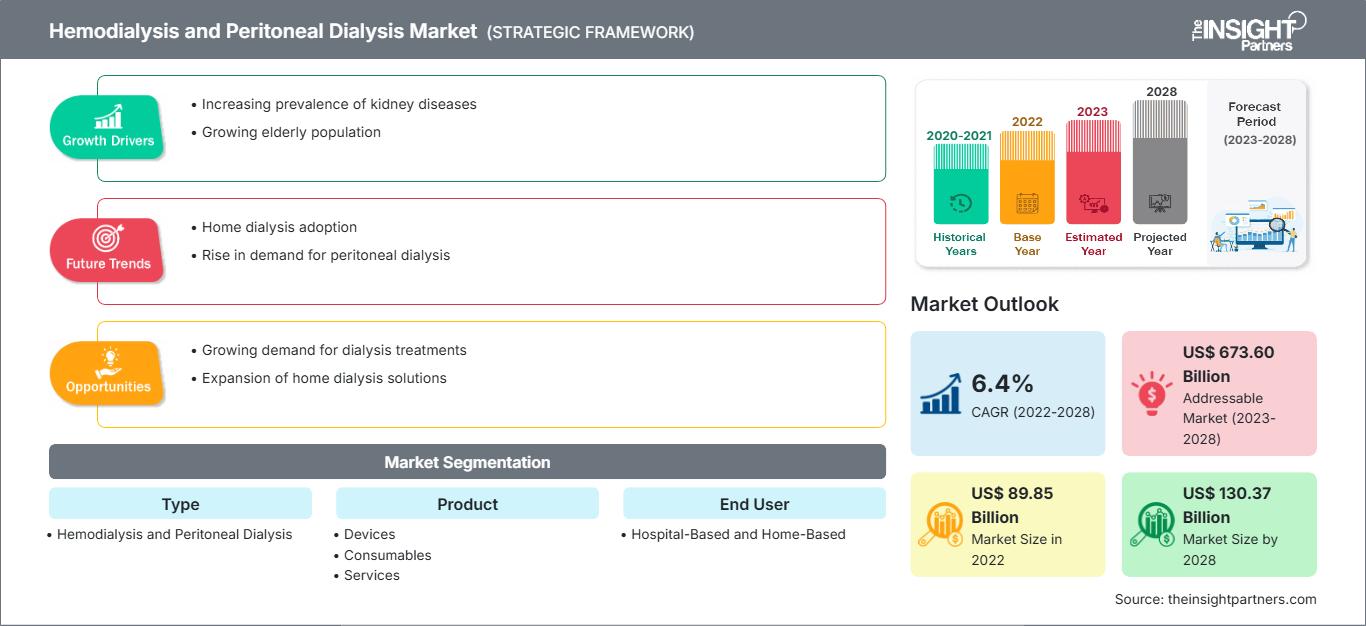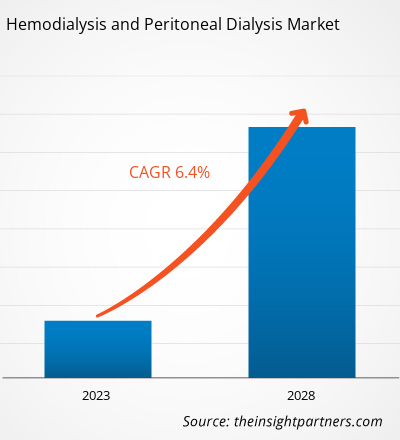Se prevé que el mercado de hemodiálisis y diálisis peritoneal alcance los 130.370,18 millones de dólares estadounidenses en 2028, frente a los 89.851,61 millones de dólares estadounidenses en 2022; se espera que crezca a una tasa de crecimiento anual compuesta (TCAC) del 6,4% entre 2022 y 2028.
Existen dos tipos de diálisis. En la hemodiálisis, la sangre se extrae del cuerpo del paciente y se bombea a una máquina de diálisis peritoneal, desde donde se devuelve al cuerpo a través de tubos conectados a la máquina. En la diálisis peritoneal, la mucosa abdominal del paciente actúa como filtro natural.
El mercado de hemodiálisis y diálisis peritoneal se segmenta por tipo, producto, usuario final y geografía. Geográficamente, se divide en Norteamérica, Europa, Asia Pacífico, Oriente Medio y África, y Sudamérica y Centroamérica. El informe de mercado de hemodiálisis y diálisis peritoneal ofrece información y un análisis exhaustivo del mercado, destacando parámetros como el tamaño, las tendencias, los avances tecnológicos y la dinámica del mercado, así como el análisis del panorama competitivo de los principales actores a nivel mundial. Además, el informe incluye el impacto de la pandemia de COVID-19 en el mercado de hemodiálisis y diálisis peritoneal en todas las regiones.
El crecimiento del mercado de hemodiálisis y diálisis peritoneal se atribuye al aumento del número de pacientes con enfermedad renal terminal, al incremento de la incidencia de insuficiencia renal y disfunción renal crónica en la población, y a la escasez de donantes de órganos. Sin embargo, las dificultades con el reembolso en los mercados emergentes limitan dicho crecimiento.
Obtendrá personalización gratuita de cualquier informe, incluyendo partes de este informe, análisis a nivel de país y paquetes de datos de Excel. Además, podrá aprovechar excelentes ofertas y descuentos para empresas emergentes y universidades.
Mercado de hemodiálisis y diálisis peritoneal: Perspectivas estratégicas

- Obtenga las principales tendencias clave del mercado que se describen en este informe.Esta muestra GRATUITA incluirá análisis de datos, que abarcarán desde tendencias de mercado hasta estimaciones y pronósticos.
Perspectivas del mercado
El aumento de la prevalencia de las enfermedades renales impulsa el crecimiento del mercado de hemodiálisis y diálisis peritoneal.
La enfermedad renal crónica (ERC) y la lesión renal aguda (LRA) son afecciones en las que los riñones se dañan y no pueden filtrar la sangre correctamente. Debido a esto, el exceso de líquido y desechos sanguíneos se acumulan en el cuerpo, lo que puede causar otros problemas de salud, como enfermedades cardíacas y accidentes cerebrovasculares. La ERC suele empeorar con el tiempo, incluso aunque el tratamiento haya demostrado una progresión lenta. Si no se trata, la ERC puede progresar a insuficiencia renal y enfermedad cardiovascular prematura. En la ERC, cuando los riñones dejan de funcionar, se necesita diálisis o un trasplante de riñón para sobrevivir. Cuando se trata con diálisis o trasplante de riñón, esta insuficiencia renal se denomina enfermedad renal terminal (ERT). Según los Centros para el Control y la Prevención de Enfermedades (CDC), aproximadamente 36 millones de adultos padecen ERC en Estados Unidos. Además, cada 24 horas, 360 personas comienzan un tratamiento de diálisis por insuficiencia renal. En 2017, se registraron 697,5 millones de casos de ERC (en todas sus etapas) en todo el mundo, con una prevalencia global del 9,1 %. La creciente prevalencia de la ERT es también uno de los principales factores que impulsan el mercado. Por ejemplo, según el Sistema de Datos Renales de Estados Unidos (USRDS), casi 786 000 personas en el país viven con enfermedad renal crónica terminal (ERCT), también conocida como insuficiencia renal terminal (IRT). Por lo tanto, la creciente prevalencia de la enfermedad renal crónica, la lesión renal aguda y la enfermedad renal crónica terminal, que conlleva la necesidad de diálisis, está impulsando el mercado de la hemodiálisis y la diálisis peritoneal.
Perspectivas basadas en tipos
Según su tipo, el mercado de hemodiálisis y diálisis peritoneal se divide en hemodiálisis y diálisis peritoneal. En 2022, el segmento de hemodiálisis representó la mayor parte del mercado. Además, se prevé que este mismo segmento registre una tasa de crecimiento anual compuesta (TCAC) del 6,7 % durante el período de pronóstico.
Información basada en el producto
Según el tipo de producto, el mercado de hemodiálisis y diálisis peritoneal se divide en dispositivos, consumibles y servicios. El segmento de servicios ostentó la mayor cuota de mercado en 2022. Sin embargo, se prevé que el segmento de consumibles registre la mayor tasa de crecimiento anual compuesto (TCAC) del 7,5 % durante el período de pronóstico.
Información basada en el usuario final
Según el usuario final, el mercado de hemodiálisis y diálisis peritoneal se divide en hospitalaria y domiciliaria. El segmento hospitalario representó la mayor cuota de mercado en 2022. Sin embargo, se prevé que el segmento domiciliario registre una tasa de crecimiento anual compuesta (TCAC) superior, del 7,4 %, durante el período de pronóstico.
Los participantes en el mercado de la hemodiálisis y la diálisis peritoneal adoptan estrategias orgánicas, como el lanzamiento y la expansión de productos, para ampliar su presencia y cartera de productos en todo el mundo, así como para satisfacer la creciente demanda.
Perspectivas regionales del mercado de hemodiálisis y diálisis peritoneal
Los analistas de The Insight Partners han explicado en detalle las tendencias regionales y los factores que influyen en el mercado de hemodiálisis y diálisis peritoneal durante el período de previsión. Esta sección también analiza los segmentos y la geografía del mercado de hemodiálisis y diálisis peritoneal en Norteamérica, Europa, Asia Pacífico, Oriente Medio y África, y Sudamérica y Centroamérica.
Alcance del informe de mercado sobre hemodiálisis y diálisis peritoneal
| Atributo del informe | Detalles |
|---|---|
| Tamaño del mercado en 2022 | US$ 89.850 millones |
| Tamaño del mercado para 2028 | US$ 130.370 millones |
| Tasa de crecimiento anual compuesto global (2022 - 2028) | 6,4% |
| Datos históricos | 2020-2021 |
| período de previsión | 2023-2028 |
| Segmentos cubiertos | Por tipo
|
| Regiones y países cubiertos | América del norte
|
| Líderes del mercado y perfiles de empresas clave |
|
Densidad de los participantes en el mercado de hemodiálisis y diálisis peritoneal: comprensión de su impacto en la dinámica empresarial
El mercado de hemodiálisis y diálisis peritoneal está creciendo rápidamente, impulsado por la creciente demanda de los usuarios finales debido a factores como la evolución de las preferencias de los consumidores, los avances tecnológicos y una mayor conciencia de los beneficios del producto. A medida que aumenta la demanda, las empresas amplían su oferta, innovan para satisfacer las necesidades de los consumidores y aprovechan las nuevas tendencias, lo que impulsa aún más el crecimiento del mercado.

- Obtenga una visión general de los principales actores del mercado de hemodiálisis y diálisis peritoneal.
Por geografía
Según su ubicación geográfica, el mercado de hemodiálisis y diálisis peritoneal se segmenta en Norteamérica (EE. UU., Canadá y México), Europa (Reino Unido, Alemania, Francia, Italia, España y el resto de Europa), Asia Pacífico (China, Japón, India, Australia, Corea del Sur y el resto de Asia Pacífico), Oriente Medio y África (Emiratos Árabes Unidos, Arabia Saudita, Sudáfrica y el resto de Oriente Medio y África) y Sudamérica y Centroamérica (Brasil, Argentina y el resto de Sudamérica y Centroamérica). Algunas de las empresas líderes en este mercado son Fresenius Medical Care AG & Co KGaA; DaVita Inc.; Baxter International Inc.; B. Braun Melsungen AG; Diaverum; Nipro Medical Corporation; Asahi Kasei Medical Co., Ltd.; Rockwell Medical, Inc.; y Dialife SA.
- Análisis histórico (2 años), año base, pronóstico (7 años) con CAGR
- Análisis PEST y FODA
- Tamaño del mercado, valor/volumen: global, regional y nacional
- Industria y panorama competitivo
- Conjunto de datos de Excel
Informes recientes
Testimonios
Razón para comprar
- Toma de decisiones informada
- Comprensión de la dinámica del mercado
- Análisis competitivo
- Información sobre clientes
- Pronósticos del mercado
- Mitigación de riesgos
- Planificación estratégica
- Justificación de la inversión
- Identificación de mercados emergentes
- Mejora de las estrategias de marketing
- Impulso de la eficiencia operativa
- Alineación con las tendencias regulatorias




















 Obtenga una muestra gratuita para - Mercado de hemodiálisis y diálisis peritoneal
Obtenga una muestra gratuita para - Mercado de hemodiálisis y diálisis peritoneal